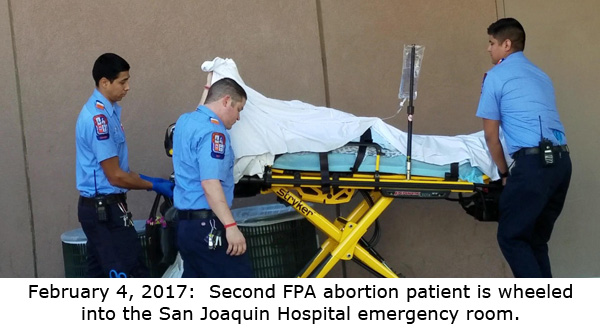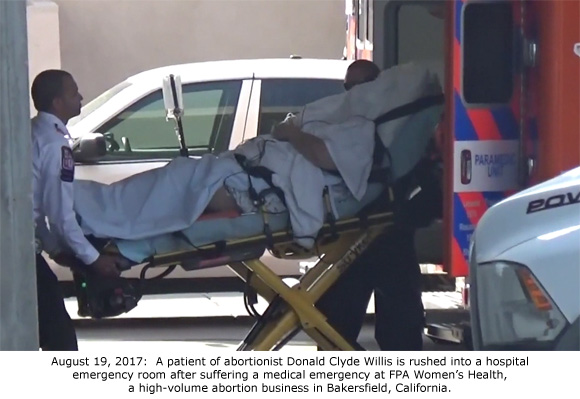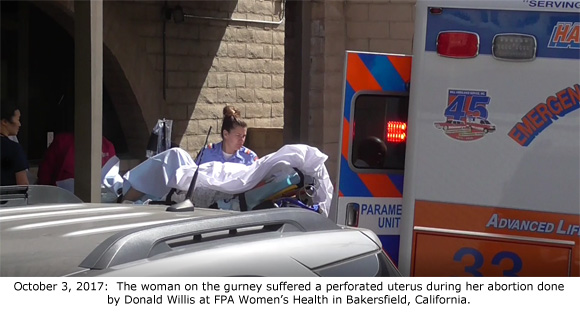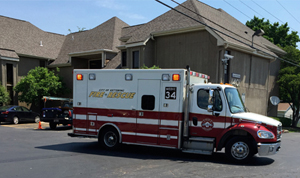
Medical Board of California filed a formal accusation against Donald Clyde Willis on August 7, 2020.
By Cheryl Sullenger
Sacramento, CA — In 2017, the Family Planning Associates in Bakersfield, California, was considered one of the most dangerous abortion facilities in America. That was due largely to a man named Donald Clyde Willis.
Willis wasn’t always an abortionist.
His life changed when he went through a divorce in 1993. Despondent over the breakup of his marriage, Willis, walked over to a park near his Oregon home on the night of September 20, 1993, put a revolver to his head and pulled the trigger. The next morning, a passerby found him and called 911.
Willis claimed in a 1996 medical board case that he never lost consciousness after he attempted suicide. He underwent surgery to remove bone and part of his brain. Once he recovered enough, he was admitted to a mental ward where he was treated for three months.
In danger of losing his medical license, Willis made a voluntary agreement with the Oregon Board of Medical Examiners to numerous restrictions on his ability to practice medicine.
It was then that Donald Clyde Willis decided to become an abortionist.
During the year 2017, Willis worked for Family Planning Associates, a chain of California abortion facilities now known as FPA Women’s Health. During a nine-month period that year, he was responsible for sending six women to the hospital, all of which suffered abortion complications due to his abortions. On January 17, 2018, he sent his seventh woman by ambulance to the hospital after she suffered complications to a botched laminaria insertion conducted the day before in preparation for a second trimester abortion.
Operation Rescue lodged a complaint against Willis with the Medical Board of California on October 3, 2017, the same day that the sixth medical emergency took place at the Bakersfield FPA.
Accusation filed by Medical Board
Nearly three years later, California Attorney General Xavier Becerra filed a formal Accusation on behalf of the Medical Board of California (MBC) against Willis based on three of those 2017 emergencies. The complaint involves three Causes for Discipline related to multiple allegations of gross negligence, repeated negligent acts, and failure to maintain adequate and accurate medical records.
The MBC is seeking disciplinary action up to and including license suspension or revocation.
Patient A
According to the accusation, dated August 7, 2020, Patient A, 28, was 17 weeks 3 days pregnant when she reported to the Bakersfield FPA for the final day of a Dilation and Evacuation (D&E) dismemberment abortion on February 4, 2017.

After her abortion, her bleeding began to increase. Willis returned her to the operating room when he conducted an aspiration abortion under ultrasound guidance and removed a “small amount of additional tissue.”
Fearing he had perforated her uterus, Willis had Patient A transferred by ambulance to the nearby Kern Medical Center. Emergency room staff found no evidence of perforation. The patient stabilized and was discharged.
However, Willis’ medical records were a disaster. He failed to document several aspects of Patient A’s abortion, including “what tissues were removed” during the abortion, leaving hospital physicians in the dark. His failure to provide accurate and complete medical records rose to the level of gross negligence according to the formal accusation.
Patient B
Patient B was 23 years old when Willis conducted a D&E abortion on her baby at 14 weeks 2 days gestation on August 19, 2017.

According to the accusation, “Towards the end of the procedure, Respondent [Willis] noted that Patient B was suddenly jerking, and the tenaculum caused a tear of the cervix with subsequent blood loss of approximately 200 ml.”
Two hundred milliliters is equivalent to just over 7 ounces of blood.
Patient B was considered to be morbidly obese. Because of that, Willis claimed he could not address the tear and was unsure whether the baby’s head was inside her uterus or vagina at the time she was transported by ambulance to the Kern Medical Center.
At the hospital, an Ob/Gyn was called in and Patient B underwent emergency surgery where the remainder of her baby’s body was removed and her cervical tear repaired. She was then discharged from the hospital.
Once again, Willis had failed to document what body parts had been removed during the incomplete dismemberment abortion, which left the hospital surgeon at a disadvantage. The MBC noted that this failure also rose to the level of gross negligence.
Patient C
Patient C suffered the worst from her botched abortion done by Willis on October 3, 2017. Patient C was a 23-year old with a history of two prior cesarean section deliveries. She was 11 weeks 1 day pregnant at the time of her suction aspiration abortion.

Due to her unusual anatomy, Willis could not visualize the opening of the cervix, yet he blindly continued on with the abortion without the aid of ultrasonography. During the surgery, Willis was unable to remove any parts of the baby, but the mother lost 500 ml of blood, equivalent to 17.6 fluid ounces.
When her vital signs became unstable, she was rushed to the hospital by ambulance. The MBC accusation detailed what happened next:
Patient C was treated for hemorrhagic shock at the hospital, and imaging revealed a right adnexal mass consistent with an intraperitoneal [abdomanal cavity] hematoma. Patient C received 4 units of blood and proceeded to surgery. In surgery, Patient C suffered a cardiac arrest, was successfully resuscitated. The surgeons conducted an exploratory laparotomy, total abdominal hysterectomy, right salpingo-oophorectomy [removal of ovary and fallopian tube] for a right sided uterine perforation and extensive damage to the right ovary and right fallopian tube. Patient C’s pregnancy was removed with the uterus, and she received 10 additional units of blood. Five days later, on October 8, 2017, Patient C was discharged from the hospital.
[Emphasis added.]
Again, Willis’ medical records, which should have documented his treatment of Patient C, were woefully incomplete. The Board determined that Willis did not account for potential risk factors when conducting her abortion and failed to reschedule her abortion for when he had ultrasound assistance available.
Instead, Willis essentially butchered Patient C, causing severe internal injuries that nearly cost her life.
Faces license revocation
Willis faces disciplinary action that could include license revocation or suspension, if found culpable for these actions.
“It has been our experience that in the vast majority of cases where an accusation is brought by a medical board, the respondent faces disciplinary action. It is very rare for an abortionist to escape discipline in these cases,” said Troy Newman, whose organization is responsible for complaints leading to disciplinary action against dozens of abortionists.
Operation Rescue acknowledges that this disciplinary case would not have been possible without the help and documentation provided by Tim and Terri Palmquist, long-time pro-life activists in Bakersfield. At the time, the Palmquists told Operation Rescue that they observed Willis living out of his car and reporting to work in a disheveled condition.
Willis left Bakersfield in 2018, around the same time that he stopped conducting surgical abortions. He continues to work for FPA Womens’ Health, providing gynecology services in Fresno and Modesto.
“We anticipate that Willis will have his license revoked because of the severity and frequency of his negligent acts, and due to his previous discipline in Oregon,” said Newman. “It will be a relief to know that Willis will never be able to hurt another person or kill another baby again.”





